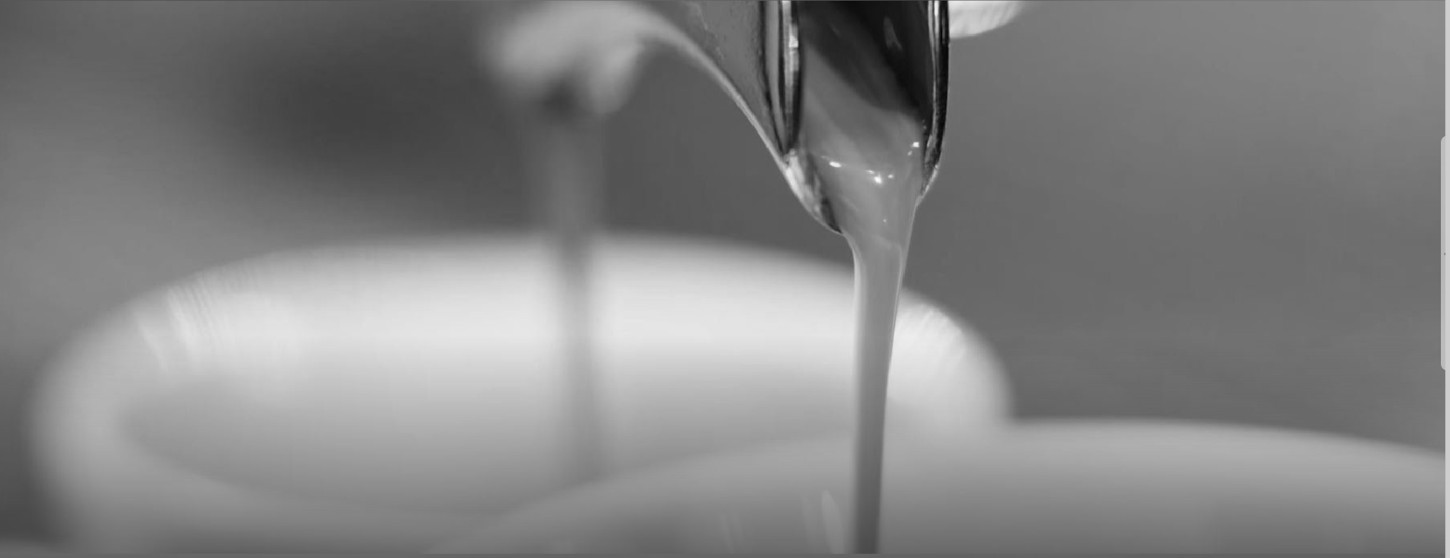The preparation at home with the traditional coffee pot, the Napoletana is part of the daily ritual of drinking homemade espresso, which, has become a symbol of Naples. Explore the culture of the cuccuma (Ku- KKUM-maa), the traditional Neapolitan flip coffee pot.
In this Article
In Naples and Italy, coffee is much more than just a drink. It’s part of culture, a tradition known all over the world that inspires values of conviviality and art. The love story between coffee and Naples is the subject of various tales: some food historians claim that it was born in the 1600s, others even two centuries earlier. The Neapolitan coffee ritual has given life to traditions, like the Caffè sospeso (suspended coffee), that evoke a sense of solidarity and altruism; or the “consuolo”, coffee, that is used as an offering to give condolences to a family in mourning.
HERITAGE: On the history, ritual, culture and tradition of Neapolitan coffee
In Naples and throughout the region of Campania – where the word “cuccuma” originates from – the Neapolitan espresso coffee pot is not just a brewing method, but also as a symbol of Naples’, possibly of South Italy’s’, distinct and unique coffee culture.
Some of the names used to refer to the cuccumella (diminutive of cucumma) are Napoletana (Neapolitan), caffettiera napoletana, (Neapolitan flip coffee maker), and even just la macchinetta (the little machine).
On the history of the Cuccumella or Napoletana (Na-po-Leh-ta-na)

Back in the 1800s and during the first half of the war ridden 1900s, the term cuccumella Ku- KKUM-eLLa must have come up, it is a diminutive of cuccum, “copper or terracotta pot”, and it derives from the late Latin cucuma “paiolo”, which is known in Petronio dictionary, of unknown origin. Also the inventor’s identity of the Neapolitan flip coffee pot remains a mystery. Two schools of thoughts prevail:
The Napoletana originates from the French drip pot
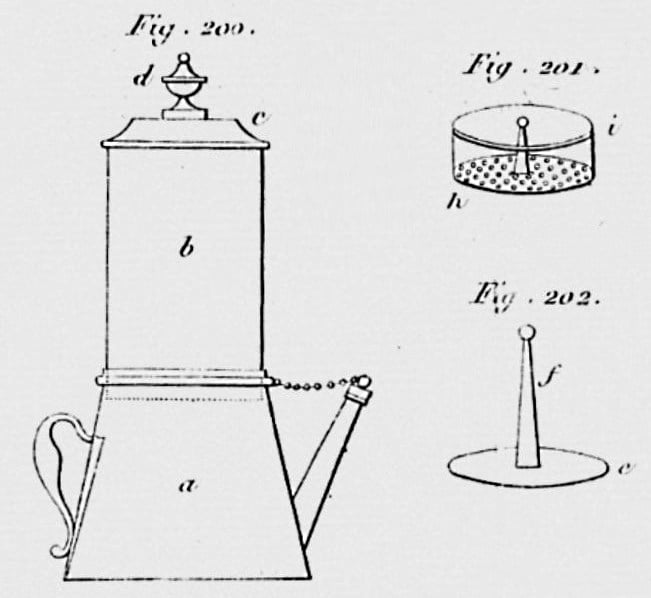
The Du Belloy coffee pot arrived in Paris in 1800. This French drip jug was first made using pewter, then porcelain and silver. Du Belloy never patented his coffee pot, so many inventors followed his creativity and made their own coffee pots. In 1802, the first French patent for a coffee pot was granted to a group of men for a “pharmacological-chemical device for preparing coffee by infusion”. In the same year, Charles Wyatt received the patent for his coffee pot in London.
In 1806, Hadrot received a patent in France for the development of a coffee pot that
“could filter coffee without boiling and bathed in air”.
Ironically, the word didn’t really mean filtration, but rather percolation back then.
Both Hadrot and De Belloy invented percolation devices. Hadrot improved De Belloy’s device by replacing the tin filter with an iron filter and adding a perforated tamper with holes to evenly distribute the coffee.
The Napoletana originates from the French double drip pot
What little literature exists on the issue, the famous “All About Coffee” written by William H. Ukers in 1922, reads:
…In 1819, Laurens produced the original of the percolation device in which the boiling water is raised by a tube and sprayed over the ground coffee. The same year Morize, a Paris tinsmith and lamp-maker, followed with a reversible, double drip pot which was the pioneer of all the reversible filtration pots of Europe and America…
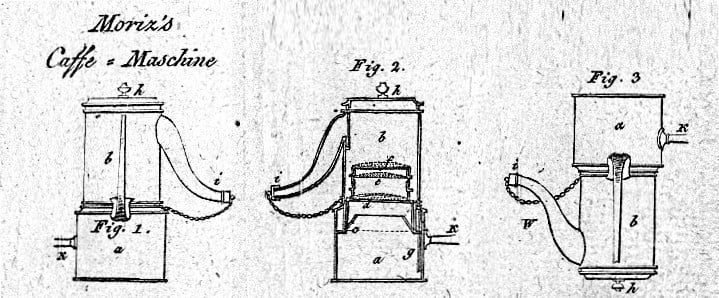
This revolutionary device was made up of two parts: an upper container that held ground coffee and an empty lower container that had a cloth filter between it and the top. In this simple yet effective setup, the standard advice for making coffee was to boil the coffee grounds in water, which is far from the best practice. As a result of this innovation, we now have access to a smoother, richer taste in coffee.
This type of coffeemaker, for is simplicity, seems to gained a great success, since we find some similar up to the 20th century, as in this Henri Matisse painting from the end of the 19th :

Percolation means the water will drip through fine interstices of metal or porcelain, while filtration means it will drip through any porous substance. Cloth and paper were the most common.
It is also the principle of the « Napolitan » coffeemaker, that is still used, especially in Italy.
Discovering the Cuccuma: Naples traditional flip coffee pot
Naples has a long and rich coffee tradition of its own, steeped in a 17th-century innovation called the cuccumella. In the 19th century, the Cuccuma had entered Italian homes. Although it is called “Neapolitana“, the coffeemaker has its origins in French inventions. Everything is blended within popular culture, it is not about where it is first created, but how a ritual lives and evolves.
The Cuccumella fully entered the Neapolitan tradition, both gastronomic and cultural: coffee became a social ritual, a moment of aggregation to be shared with the people you love, but also with illustrious strangers.
The cuccuma requires attention (it has to be turned) and sharing, it is the coffee for those who care about each other. Until the 1970s, many families in South Italy used to end their big Sunday meal, or any celebration, with coffee made using a huge cuccuma, which could serve ten or twelve people. Coffee was often bought as green beans, then roasted and grounded at home according to one’s preferences.
The Neapolitan flip coffee pot typically comes with a horn-shaped spout. This is broken – accidentally or intentionally – which is considered to be a sign of good luck.
In Naples, some say, the Cuccuma has regained favor over the Moka pot, not only for its coffee, but also for its iconic design. Southern Italian Riccardo Dalis re-created the classic design for Alessi, starting research in 1979 and going into production in 1987.
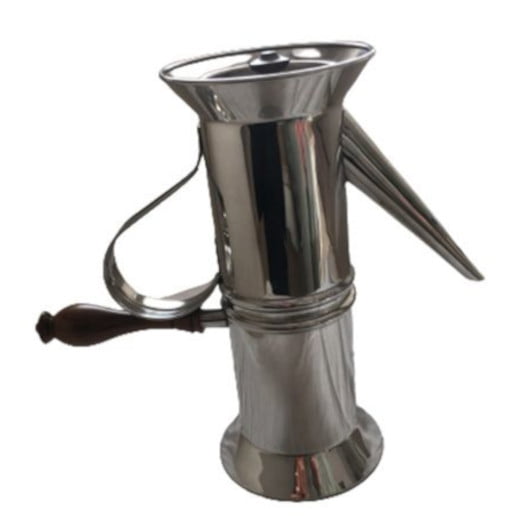
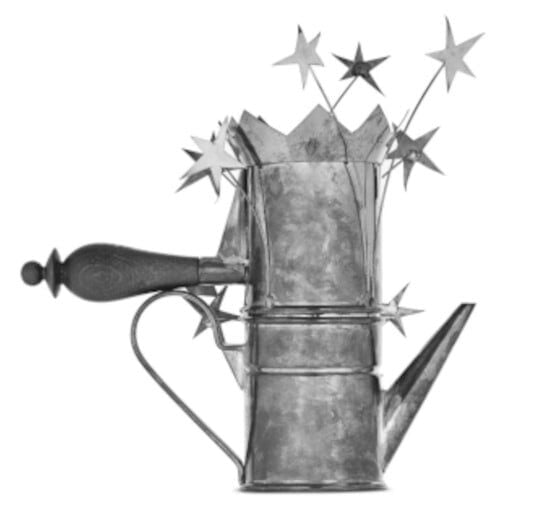
The Neapolitan coffee maker remains a slow, delightful ritual, celebrated daily in the houses as well as in the bars and coffee houses..
Neapolitan Espresso Coffee – How to prepare ‘O caffè perfetto
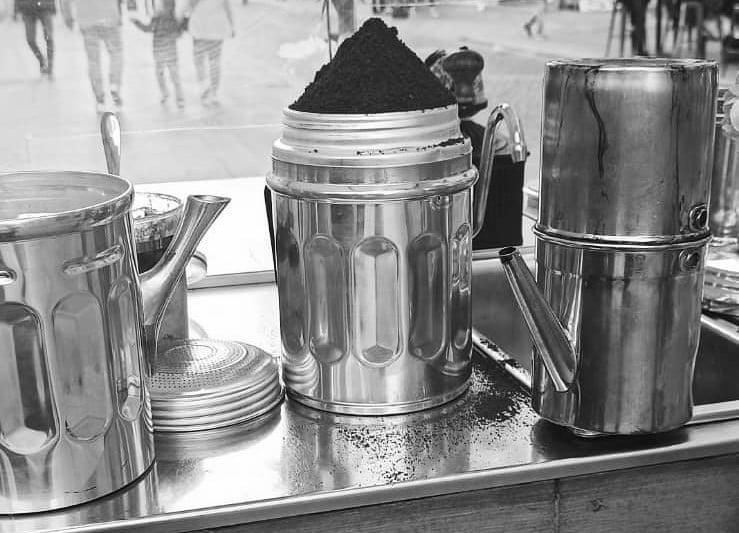
The preparation mode for the cuccumella, is perfectly expressed by the verb “to brew”, which becomes almost a ritual for all those who love not only coffee but also everything that surrounds its preparation.
‘O caffè perfetto, the perfect coffee’.
The coffee that is obtained with the Neapolitan cuccumella is as intense as an Italian espresso with a lot of body. The difference is in the aroma, which is more delicate due to the fact that the extraction of the coffee is more delicate.
Campanias (Neapolitan) roast
Neapolitans like their beans dark but not to the point of being oily and nearly black. They prefer robusta, which is cheaper and has more body. Robusta also has around twice the caffeine content of Arabica and more of the chlorogenic antioxidants responsible for many of the coffee’s health benefits. Famous roasters are: KIMBO, Caffè Toraldo, Caffè Moreno, Passalacqua, Caffè Kenon e L’ oro di Napoli.
The coffee must be to your taste and of good quality. A coarser grind is needed to prevent it from getting into the cup.
The caffettiera Napoletana is still used by Neapolitan families using ancient methods taught by their grandparents and passed from generations to generations.
The parts of the Napoletana:

A Neapolitan flip coffee maker consists of two pots resting on each other.
The preparation with the cuccuma is based on a gravity-forced drip brew. The Neapolitan coffee is made up of 5 elements that are assembled to fit between them:
Water tank, with a curved handle and a small hole in the upper side
Filter section filled with ground coffee, in the shape of a hollow cylinder open on one side and the other side with holes to allow the passage of water in boiling
Filter
Coffee container, which collects the beverage, an upside-down pot with a downwards spout that is turned upwards.
Lid for covering the brew when serving.

The flip coffee pot is placed on the flame with the spout upside down: as soon as the water boils, and a steam vent comes out of the hole in the tank, the cuccumella must be gripped firmly and turned over (thus bringing the spout back upwards) so that the hot water seeps through the coffee blend.
Girare (Gii-Ra-Reh)

Flipping is called “girare” in Italian. Make sure you do your “girare” near the sink, in case any water escapes.
The Napolitana needs a finer grind than the Moka – said to facilitate more aroma and full-bodied flavor – and it demands its ritual. The more often you make it, the better you get at it, and the better the coffee becomes.
There is a pin-sized hole that releases steam and let you know when to turn, sometimes it spouts hot water when flipping, so take care to avoid getting scalded or burned. Once the water has dripped through, the pot is served at the table with the spout upwards and covered with a lid..
Coppitello (Kopp- ii- teLLo)
During the dripping, the coppitello ( or “cuppitiello”, “cupptielo”, “coppetello”) a small cone made from newspaper or tin foil is used to cover the spout’s hole, to preserve the coffee’s aroma.
Some people in Naples will even hold the pot in hot water (as in a water bath) during the inverted dripping phase to help avoid heat loss, but you have to stand there and hold it, or it may topple over in the water.
It is also traditional to have a small glass of water first before drinking coffee, to clean your mouth so that you’ll be able to enjoy the flavor of the coffee better.
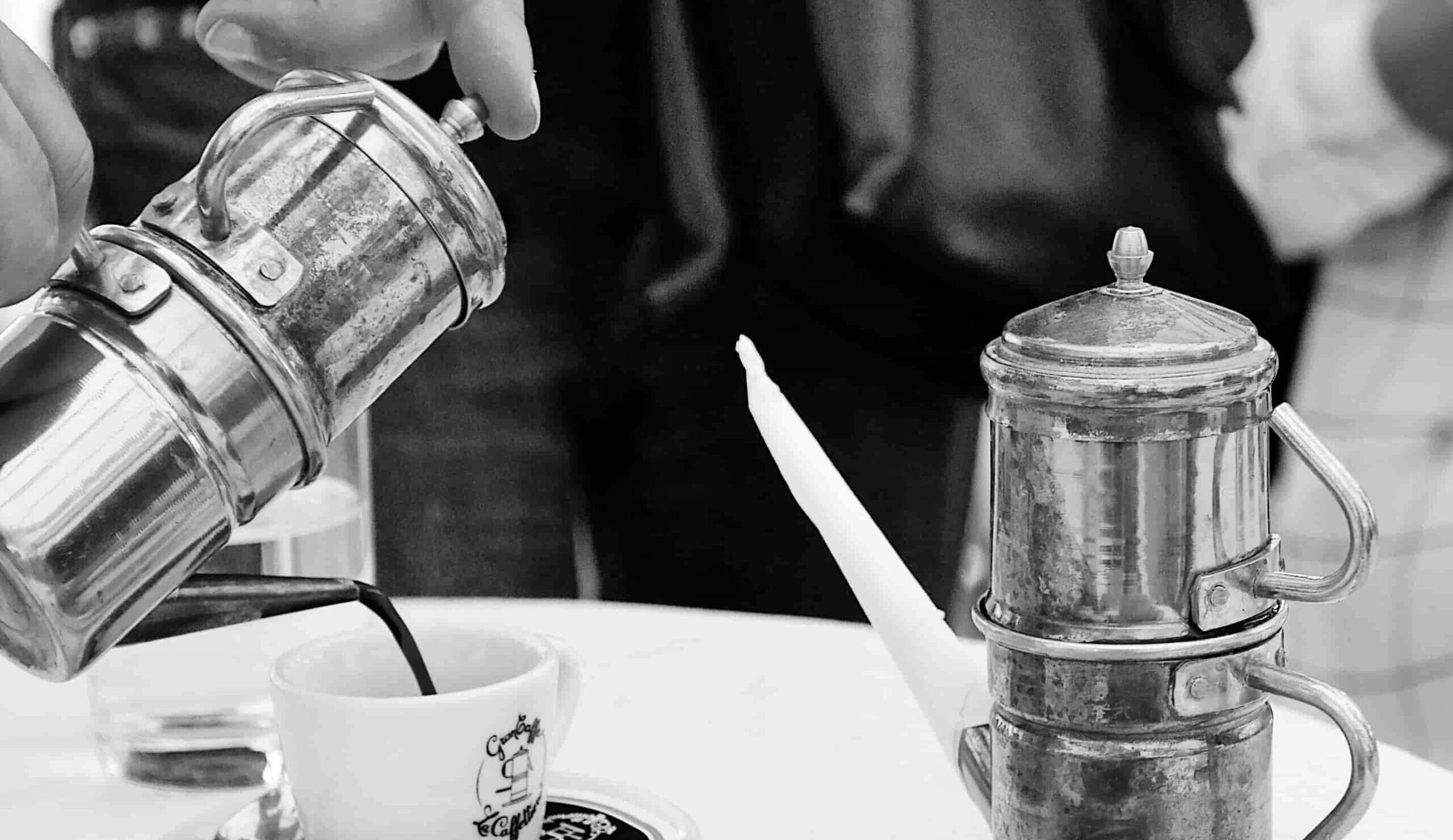
Step by step preparation for a Neapolitan – tazzulella è caffè – tiny cup of coffee:
- Measure 5-6 grams (about 1/5 oz) of medium-ground coffee per cup desired.
- Place coffee in the tank’s opening and screw on the filter.
- Add the required amount of water at the bottom of the machine, not higher than the small hole. Insert the tank with filter containing ground coffee, and screw the two parts of the machine together.
- Place the Napolitana on the stove, spout downwards, and bring water to a boil.
- Remove it from the heat when steam starts to release from the hole, holding both handles tightly. The steam escaping from the hole warns us that we have reached a temperature of 100 °C.
- Turn the cuccumella upside down, so that the water starts passing through the filter, allowing the liquid coffee to collect in the lower portion over the course of a few minutes.
- Sometimes the cuccuma needs a little tap (or a slightly harder smack) against a hard surface to start the flow of water. If it is flowing well, it doesn’t need it.
- The coffee has to be consumed strictly boiling (perhaps to be served in a cold cup so as not to burn your lips).
- Wash all parts thoroughly in warm water. Don’t put aluminum through the dishwasher. Dry thoroughly.
It takes around 10 minutes for a Napoletana coffee to be ready
Ten minutes,is the time necessary for the water to boil and, once the temperature has been reached, to turn the pot and let the water descend into the coffee tank.
A literary guide on the ceremony of preparing a Neapolitan flip over coffee pot by Eduardo De Filippo
Eduardo De Filippo an Italian actor, playwrighter, screenwriter, author and poet, is iconic in the balcony scene in Questi Fantasmi (These Ghosts, 1946). De Filippo dedicates an entire monologue to coffee, his tribute to a drink that has become a symbol of the Neapolitan tradition.
The main character Pasquale Lojacono, played by Del Filippo himself, sits out on his balcony at the beginning of the second act, explaining the preparation of coffee with a typical Neapolitan coffee pot to his neighbor, the quiet professore.
Eduardo De Filippo’s coffee monologue: On how to prepare the cuccuma
Eduardo De Filippo in his lesson on coffee explained how it is prepared with the cuccuma, underlining that the tazzulella represents above all a moment of pleasure and sharing.
Transcript of Eduardo De Filippo’s coffee monologue: On how to prepare the cuccuma
Hi! Hello, Professor! Eh, well, from us Neapolitans take away this little vent out in the balcony… Yeah!
As to me, professor,
I would sacrifice everything except this cup of coffee drunk calmly on the balcony,
after that half hour’s sleep that one has had after lunch, you know…
Excuse me, huh! And me, I have to prepare it myself, with my hands, eh, I’m very particular, right!

Huh? Ahh, my wife … no, no, no , my wife does not cooperate… you see, she is much younger than me… and the new generation has lost those habits that to me, under a certain point of view, are the poetry of life!
Yeah! In addition to let me occupy my time, it gives me some peace of mind as well …
And who could ever prepare me a cup of coffee as I prepare myself, with the same zeal, the same love… eh!
You will understand that, having to serve myself, I have the real experiences and do not neglect anything , but just … I do it with all the rules!
For example, you see professor, on the becco, bill, eh? Do you see the bill eh? This one, professor, no, here! You are looking at me! The bill (spout) of the coffee pot! Eh… no, for heaven’s sake , yea, I do not I lose my temper! I am one who can take a joke, too, you pulled my leg…
The joke referred to is on the word becco, which literally means “beak, spout” of the coffe pot in the scene, but has the further meaning of “betrayed husband” from the phrase far becco (to cheat one’s husband) and apparently derived from another meaning of becco, which is also a male goat, whose female companion changes partners with great ease.
No, I was saying, on the spout I place this paper cover coppitello , huh, now it looks nothing, this little cover? But it also has its function. Yeah, because the thick smoke of the first coffee, which is then the most intense, is not lost, on the contrary, it remains inside and impregnates the environment, prepares it to receive the substance, the coffee.
And also, professor, remember, before you pour the water –
which in my opinion must boil a couple of minutes to get those calories – before pouring it, I was telling you, into the inside of the cap with holes… no, no, the other side, where you pour the water, huh, you close the capsule, then flip over…
Eh, where you pour the water, huh, on the bottom, you have to sprinkle beforehand a half teaspoon of freshly ground powder… it’s a little secret!
Yeah, because the water, it’s true, in full boil, already gets flavored by itself at the time of pouring, huh, and then the coffee is more fragrant, is… is better!
It is a great satisfaction, and I avoid as well to realize, because, if for a damn combination the coffee comes out bad, for a wrong move, if the part above comes out, the part below, say, coffee grounds and liquid get mixed as I made it with my hands, I cannot blame anyone – I convince myself that it is good all the same… I drink it and ti saluto, goodbye!
There’s a little more… professor, you also have fun sometimes… And how not, because I see you out on the balcony to do the same … early in the morning, I see you with your newspaper eh!
And me too! Yes, yes, I find myself just with the same habits… because as I said, my wife does not cooperate – I roast it myself! Yes, yes, yes, oh well… then that is the hardest thing… eh heh!
To guess the right moment of roasting…
A manto di monaco, color manto di monaco… the color, professor, the color! A cloak of the monk, monk-coat colored… Ohhh, and what a smell! A wonder…Ohe, aahh, e questo non è caffè, è cioccolato!
Hey, aahh, and this is not coffee, it’s chocolat! See how little it takes to make a man happy: a half cup of coffee taken out on the balcony, some little fresh air, quietly… with a nice neighbor across with whom I exchange small talk… Ehh!
I allow myself a half cup, between one cigarette and another …
and the coffee should be taken with calm!
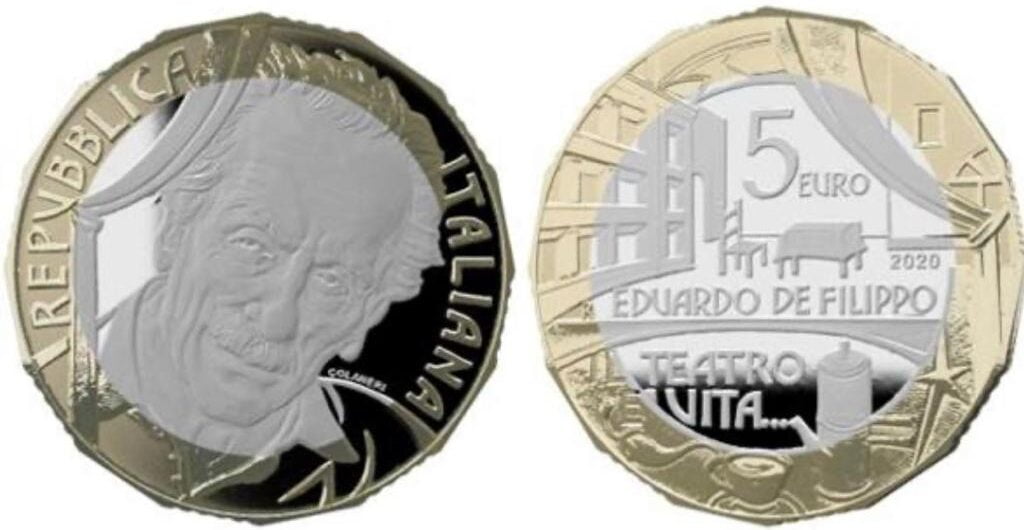
And another secret from Eduardo De Filippo:
Put a half teaspoon of coffee powder “at the bottom of the perforated part, where the water is poured”, so that “the water already has taken flavor from the powder, when it is poured”.
Coffee in Neapolitan theater, cinema and music
Coffee is deeply ingrained in habits, daily life, literature and cinema, so much so that every time the word cuccumella is used, Naples is associated. Neapolitan coffee has often been the protagonist of theater, cinema and music: With this macchinetta, according to the last custodians and connoisseurs of Neapolitan tradition, a coffee is brewed, how it was served long ago:
‘o caffè comme se fa nà vote’,
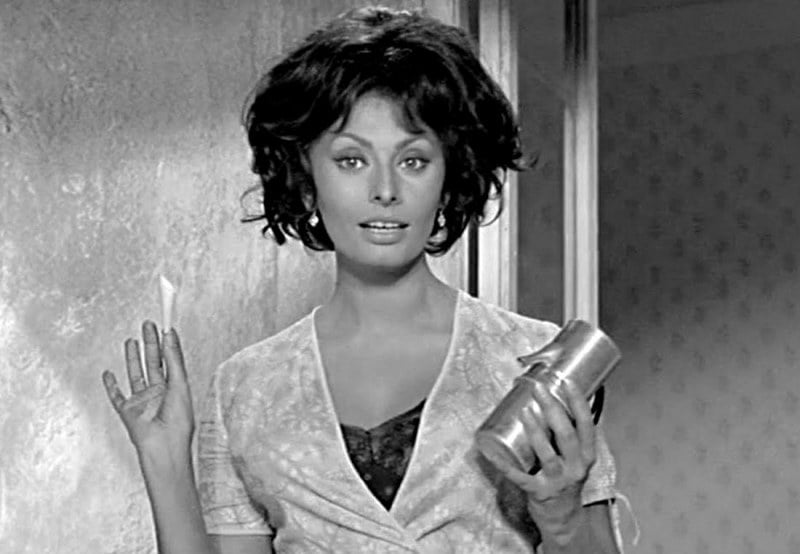
A true Neapolitan, Sofia Loren, in These Ghosts (by Del Filippo), explains to Vittorio Gassman the recipe for the perfect coffee, and uses it as an excuse to shorten distances.
Totò , also a famous Neapolitan, talked about coffee in many movies he was part of. In the film “Totò a colori” when, as a Capri guest, is offered a coffee, he blurts out “this caffè is nà ciofeca!”.
Ciofeca? This word should derive from the Arabic “scìafek” (which is also very reminiscent of “crap”). The meaning could also describe something of low quality or, rightly so, a poor liquid. An undrinkable slop?
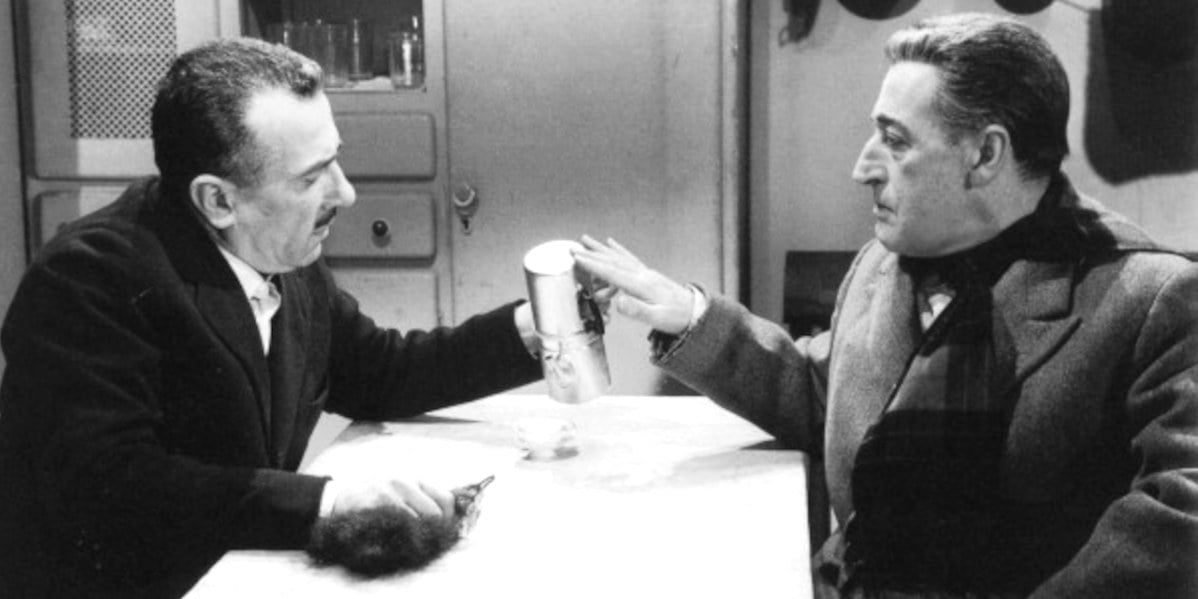
In La banda degli onesti, the honest gang Totò explained the famous metaphor of coffee without sugar to Peppino De Filippo. In the 1956 movie, he used the metaphor of the sugar to show the concept of capitalism. Pouring excessive quantities into his espresso, while that of Peppino, remained bitter. Lots of sugar represent the greed of the capitalists and is used to justify the attempt to manufacture fake banknotes, which then the “honest gang” would not have had the heart to deal.
Since nothing could be more Neapolitan than a song about coffee, here it is: “Na’tazzulella ’e caffè” – from Neapolitan dialect: a little cup of coffee – it sings about the meaning of coffee, sweet pastries, like sfogliatella or babà, and enjoying life. To paraphrase Pino Daniele:
“Without coffee, what would it mean to be Neapolitan? Without sfogliatella or babà? These are not just everyday habits – they are a way of life, so full of pleasure that you may need to close your eyes with each sip and bite.”
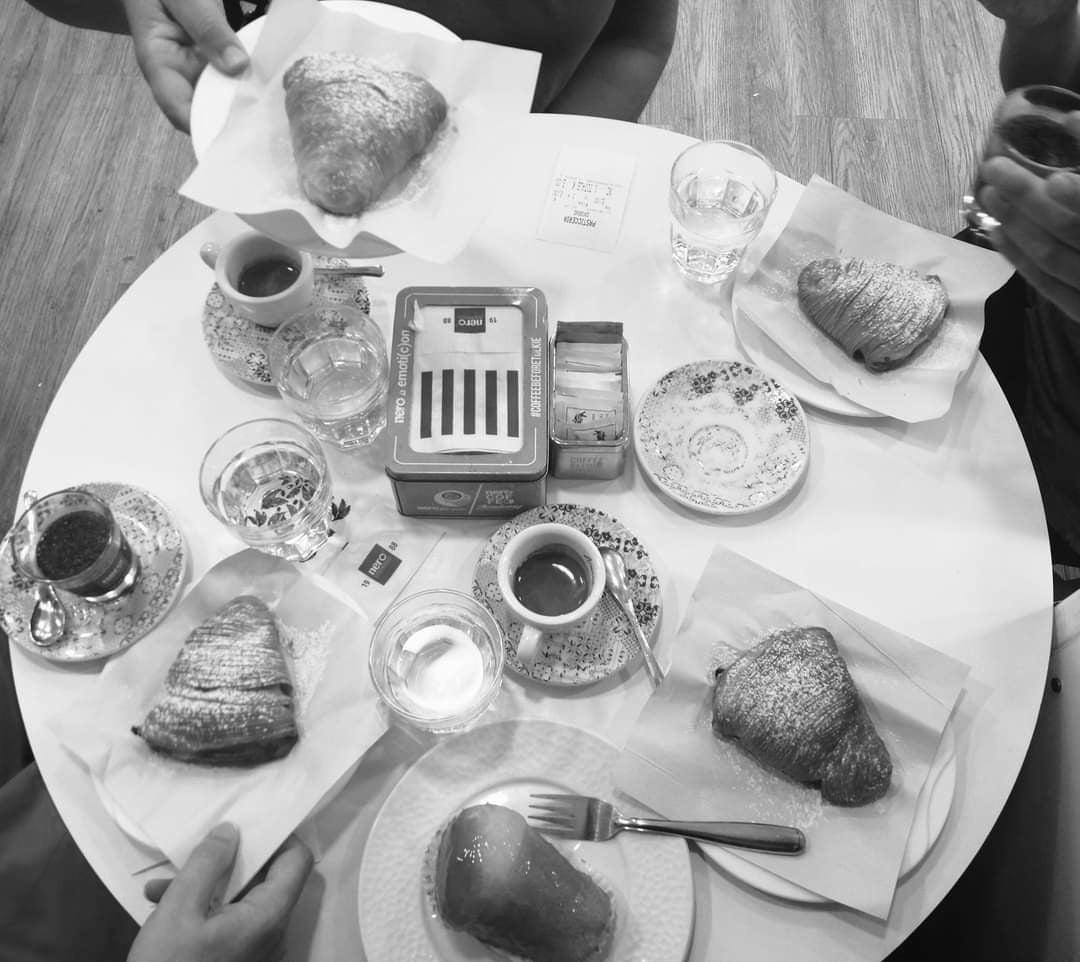
Pino Daniele, with this song also rejects the bad habit of the powerful to keep the population in ignorance, granting them only that little – metaphorical cup of coffee – however, it is sufficient to keep the masses calm, even in widespread malaise, they fatalistically, accept any cup of coffee.
“Na’ tazzulella e’ caffè e mai niente cè fanno sapè nui cè puzzammo e famme o sanno tutte quante e invece e c’aiutà c’abboffano e’ caffè”.
And it is no coincidence that Domenico Modugno in one of his songs from 1958 sang:
“Ah, what a wonderful caffé, just in Naples and no one can explain why it is a real specialty”.

“Ah, che bellu caffè, sulo a Napule ‘o sanno fa e nisciuno se spiega perché è na vera specialità”.
Folklore has it, that Neapolitan espresso coffee is special because of the local water quality.
However, its secret lies not in the water, but rather in the roasting of the coffee beans, which makes it darker than that used in the rest of Italy, so much so that it is said to be “cooked to perfection”.
Eduardo De Filippo in one of his best-known works “Natale in casa Cupiello” from 1931, turning to his wife Concetta, says about her lovingly prepared coffee:
chisto fete ‘e scarrafune…
Coffee is not for you. You don’t know how to make it and you don’t want to make it, because you want to save money. You don’t save money with coffee. It is of poor quality: chisto fete ‘e scarrafune… literal, this coffee tastes like cockroach.
And again De Crescenzo, with his historic question:
“Have you ever wondered what a coffee is?
A coffee is an excuse to tell a friend that you love him”.
Neapolitan Cuccuma espresso or classic moka pot espresso?

There is no limit to the number of coffee-making devices you can buy and the money you can spend on them. But it is possible to make excellent coffee at home with simple equipment, like using a Neapolitan Cuccuma or a Moka. The cuccuma and the Moka make no crema, but are easy to use, and not expensive.
Call it whatever you like, Moka, Napoletana, coffee pot, coffee machine, cuccuma, cuccumella, jug, old wheelbarrow, but one thing is certain: it is essential for making Classic Italian coffee at home.
Both historic Italian coffee makers remain timeless, because the “machinette – small machines” do not just make coffee: they make tradition, folklore and heritage, they make memories, they make perfume, they make us happy, they make us nostalgic, they make us feel like family even if we are away from home.

The type of coffee and the pattern of consumption are associated with social habits and culture of the single regions of Italy. Variations in raw bean composition, in roasting conditions and in the extraction procedures used to prepare coffee brews result in a great diversity of the tazzulella (cup) of coffee.
The human mind has developed an extraordinary variety of brewing techniques, so Petracco, 2001, used traditionally in different countries:
- decoction methods (boiled coffee, Turkish coffee, percolator coffee and vacuum coffee),
- infusion methods (drip filter coffee, Indian filter Kapi and Napoletana), and
- the original Italian pressure methods (Moka and espresso)
The Napoletana uses gravity.
Unlike the Moka pot, which uses steam.
The cuccuma brews coffee through percolation, where the hot water drips through the coffee and filters into the lower container, with the moka pot, the water doesn’t percolate; instead, the pressure within the boiling water in the lower chamber forces it upwards through the coffee. This pressurized extraction takes place under more intense circumstances. This in turn causes the coffee to be heavier, with a thicker mouthfeel and more body, almost like an espresso.
As we embrace the aromas of an Italian coffee, we’re reminded that every demitasse, every bean, and every fragrance is a testament to the beauty of the sensory world we inhabit — a world enriched by the magic of flavors that have the power to transport us, awaken memories, and stir emotions.
Chocolaty, fruity and floral describe the papillary sensations of a great cup of coffee. Whether you’re a casual coffee drinker or a seasoned coffee connoisseur, the magic of coffee offers a moment of joy that can be savored each and every day, in Italy several times a day.
Coffee is essentially a matter of personal taste and heritage – it’s your cup of coffee
De gustibus non est disputandum.
There is no arguing about taste.
~ ○ ~
Keep exploring:
Works Cited & Multimedia Sources
The history of coffee is an extraordinary study. If you would like to learn more about it, I heartily recommend the book, All About Coffee, by William Ukers. Written in 1928, it will delight you with detail.
- it.wikiquote.org (https://it.m.wikiquote.org/wiki/Voci_e_gridi_di_venditori_napoletani)
Voci e gridi di venditori napoletani - Allegra World Coffee Portal www.worldcoffeeportal.com
- Artusi Pellegrino. Science in the Kitchen and the Art of Eating Well, transl. Murtha Baca and Stephen Sartarelli. 2003.
- Biderman Bob. A people’s history of coffee and cafés. 2013.
- Café Culture Magazine www.cafeculturemagazine.co.uk
- Carosello Bialetti: la caffettiera diventa mito https://www.famigliacristiana.it/video/carosello-bialetti-moka-mito.aspx
- Cociancich Maurizio. Storia dell’ espresso nell’Italia e nel mondo. 100% Espresso Italiano. 2008.
- Coffee Connaisseur www.coffeeconnaisseur.com
- Coffee Geek www.coffeegeek.com
- Coffee Origins’ Encyclopedia www.supremo.be
- Coffee Research www.coffeeresearch.org
- Coffee Review www.coffeereview.com
- Coffee Sage www.coffeesage.com
- Coffeed.com www.coffeed.com
- Comunicaffe International www.comunicaffe.com
- Davids Kenneth. Espresso Ultimate Coffee. 2001.
- De Crescenzo Luciano. Caffè sospeso. Saggezza quotidiana in piccoli sorsi. 2010.
- De Crescenzo. Luciano. Il caffè sospeso.
- Eco Umberto. “La Cuccuma maledetta” in Agostino Narizzano, Caffè: Altre cose semplici. 1989.
- Global Coffee Report www.gcrmag.com
- Gusman Alessandro. Antropologia dell’olfatto. 2004.
- Hippolyte Taine, wrote in, Italy: Florence and Venice, trans J. Durand. 1869.
- https://www.italienaren.org/tradizioni-italiane-caffe-in-ginocchio/
- http://www.archiviograficaitaliana.com/project/322/illycaff
- http://www.baristo.university/userfiles/PDF/INEI-M60-ENG-Public-Regulation-EICH-v4-1.pdf
- http://www.coffeetasters.org/newsletter/en/index.php/category/a-baristas-life/
- http://www.coffeetasters.org/newsletter/it/index.php/il-galateo-del-caffe/01524/
- http://www.culturaacolori.it/fascismo-contro-le-parole-straniere/
- http://www.espressoitaliano.org/en/The-Certified-Italian-Espresso.html
- http://www.inei.coffee/en/Welcome.html
- https://archiviostorico.fondazionefiera.it/entita/585-bialetti-industrie
- https://bialettistory.com/
- https://cdn.intechopen.com/pdfs/55623.pdf Severini Carla. Derossi Antonio. Ricci Ilde. Fiore Anna Giuseppina. Caporizzi Rossella. How Much Caffeine in Coffee Cup? Effects of Processing Operations, Extraction Methods and Variables
- https://en.wikipedia.org/wiki/Drip_coffee#Cafeti%C3%A8re_du_Belloy
- https://en.wikipedia.org/wiki/ISSpresso
- https://en.wikipedia.org/wiki/Italian_meal_structure
- https://en.wikipedia.org/wiki/Neapolitan_flip_coffee_pot
- https://hal.science/hal-00618977/document
- https://hub.jhu.edu/magazine/2023/spring/jonathan-morris-coffee-expert/
- https://ineedcoffee.com/the-story-of-the-bialetti-moka-express/
- https://it.wikipedia.org/wiki/Caff%C3%A8
- https://it.wikipedia.org/wiki/Caff%C3%A8#Risvolti_etici_e_sociali
- https://it.wikipedia.org/wiki/Napoletana
- https://italofonia.info/la-politica-linguistica-del-fascismo-e-la-guerra-ai-barbarismi/
- https://italysegreta.com/italian-hospitality-the-invite/
- https://library.ucdavis.edu/wp-content/uploads/2022/06/LangPrize-2017-ElizabethChan-Project.pdf
- https://memoriediangelina.com/2009/08/11/italian-food-culture-a-primer/
- https://mostre.cab.unipd.it/marsili/en/130/the-everyday-eighteenth-century
- https://napoliparlando.altervista.org/cuccumella-la-caffettiera-napoletana/
- https://specialcoffeeitaly.com/barista-espresso-coffee-machine/
- https://specialcoffeeitaly.com/italian-breakfast-cappuccino-cornetto/?_gl=1*1gjfoya*_ga*OTE0MDM2ODM5LjE2OTMzNjE5OTg.*_ga_2HTE5ZB0JS*MTY5MzM2MTk5Ny4xLjEuMTY5MzM2Mjk0NS4wLjAuMA../
- https://specialcoffeeitaly.com/what-came-first-the-italian-bar-or-coffee/
- https://themokasound.com/
- https://uwyoextension.org/uwnutrition/newsletters/understanding-different-coffee-roasts/
- https://www.adir.unifi.it/rivista/1999/lenzi/cap2.htm
- https://www.bialetti.co.nz/blogs/making-great-coffee/using-bialetti-coffee-makers
- https://www.bialetti.com/ee_au/our-history?___store=ee_au&___from_store=ee_en
- https://www.bialetti.com/it_en/inspiration/post/ground-coffee-for-moka-should-never-be-pressed
- https://www.brepolsonline.net/doi/pdf/10.1484/J.FOOD.1.102222
- https://www.coffeeartproject.com/TheCollection/Amsterdam/2014.aspx
- https://www.coffeeartproject.com/TheCollection/Amsterdam/2014.aspx
- https://www.coffeeartproject.com/TheCollection/Milan/2013/Gallery/Other/Amalia-Chieco
- https://www.coffeeartproject.com/TheCollection/NewYork/2016.aspx
- https://www.coffeeartproject.com/TheCollection/NewYork/2017.aspx
- https://www.coffeeartproject.com/TheCollection/NewYork/2018.aspx
- https://www.coffeeartproject.com/TheCollection/NewYork/2019.aspx
- https://www.coffeeresearch.org/science/aromamain.htm
- https://www.coffeereview.com/coffee-reference/from-crop-to-cup/serving/milk-and-sugar/
- https://www.comitcaf.it/
- https://www.ecf-coffee.org/wp-content/uploads/2023/05/European-Coffee-Report-2022-2023.pdf
- https://www.espressoitalianotradizionale.it/
- https://www.euronews.com/culture/2022/02/15/the-italian-espresso-makes-a-bid-for-unesco-immortality
- https://www.faema.com/int-en/product/E61/A1352IILI999A/e61-legend
- https://www.finestresullarte.info/en/works-and-artists/the-bialetti-moka-the-ultimate-romantic-design-object
- https://www.finestresullarte.info/opere-e-artisti/moka-bialetti-oggetto-design-ultimi-romantici
- https://www.freemalaysiatoday.com/category/leisure/food/2022/02/15/italy-woos-unesco-with-magic-coffee-ritual/
- https://www.gaggia.com/legacy/
- https://www.gamberorossointernational.com/news/coffee-10-false-myths-to-dispel-on-the-beverage-most-loved-by-italians/
- https://www.gcrmag.com/calls-to-review-price-structure-of-italian-espresso/
- https://www.granaidellamemoria.it/index.php/it/archivi/caffe-espresso-italiano-tradizionale
- https://www.illy.com/en-us/coffee/coffee-preparation/how-to-make-moka-coffee
- https://www.illy.com/en-us/coffee/coffee-preparation/how-to-use-neapolitan-coffee-maker
- https://www.ilpost.it/2011/06/08/itabolario-bar-1897/
- https://www.itstuscany.com/en/bar-where-the-word-comes-from/“Cafe Hawelka”, John A. Irvin
- https://www.lastampa.it/verbano-cusio-ossola/2016/02/17/news/le-ceneri-di-renato-bialetti-nella-sua-moka-con-i-baffi-1.36565348/
- https://www.lavazza.com/en/coffee-secrets/neapolitan-coffee-maker
- https://www.lavazzausa.com/en/recipes-and-coffee-hacks/making-espresso-at-home
- https://www.linkedin.com/pulse/third-wave-coffee-meets-tradition-neapolitan-maker-bruno-lopez
- https://www.mumac.it/we-love-coffee-en/be-our-guest-en/progettazione-e-rito/?lang=en
- https://www.quartacaffe.com/images/pdf/carta-dei-valori.pdf
- https://www.repubblica.it/il-gusto/2021/07/26/news/caffe_il_piu_clamoroso_equivoco_gastronomico_d_italia-311835974/
- https://www.taccuinigastrosofici.it/ita/news/contemporanea/semiotica-alimentare/print/Pop-cibo-di-sostanza-e-circostanza.html
- https://www.thehistoryoflondon.co.uk/coffee-houses/
- https://www.wien.gv.at/english/culture-history/viennese-coffee-culture.html
- Illy Andrea. Viani Rinantonio. Furio Suggi Liverani. Espresso Coffee. The Science of Quality. 2005.
- International Coffee Organization www.ico.org
- Kerr Gordon. A Short History of Coffee. 2021.
- La cremina per il caffè: come farla bene. https://www.lacucinaitaliana.it/news/cucina/come-fare-la-cremina-del-caffe/
- Allen Lee Stewart. Devil’s Cup. A History of the World According to Coffee. 1999.
- Leonetto Cappiello – Wikipedia page on the creator of the 1922 poster La Victoria Aduino.
- Markman Ellis. The Coffee House. A Cultural History. 2005.
- Mennell Stephen. All Manners of Food. Eating and Taste in England and France. 1996.
- Montanari Massimo. Il riposo della polpetta e altre storie intorno al cibo. 2011.
- Montanari Massimo. Il sugo della storia. 2018.
- Morris Jonathan. A Short History of Espresso in Italy and the World. Storia dell’espresso nell’Italia e nel mondo. In M. Cociancich. 100% Espresso Italiano. 2008.
- Morris Jonathan. Coffee: A Global History. 2019.
- Morris Jonathan. Making Italian Espresso, Making Espresso Italian.
- National Coffee Association www.ncausa.org
- Pazzaglia Riccardo. Odore di Caffe’. 1999.
- Pendergrast Mark. Uncommon Grounds. The History of Coffee and How It Transformed Our World. 2019.
- Perfect Daily Grind www.perfectdailygrind.com
- Scaffidi Abbate Mario. I gloriosi Caffè storici d’Italia. Fra storia, politica, arte, letteratura, costume, patriottismo e libertà. 2014.
- Schnapp Jeffrey. The Romance of Caffeine and Aluminum. Critical Inquiry. 2001.
- Sibal Vatika. Food: Identity of culture and religion. 2018.
- Specialty Coffee Association www.sca.coffee
- Spieler Marlena. A Taste of Naples. 2018.
- Tea and Coffee Trade Journal www.teaandcoffee.net
- The Long History of the Espresso Machine. www.smithsonianmag.com
- The Pleasures and Pains of Coffee by Honore de Balzac
- The relaxation ritual https://themokasound.com/
- Tucker, Catherine M. Coffee Culture: Local Experiences, Global Commensality, Society and Cuture 2011.
- Virtual Coffee www.virtualcoffee.com
- World Coffee Research www.worldcoffeeresearch.org

